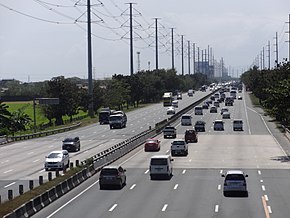| South Luzon Expressway | |
|---|---|
| South Superhighway | |
 Map of expressways in Luzon, with the South Luzon Expressway in orange | |
 The expressway in Carmona, Cavite | |
| Route information | |
| Part of | |
| Maintained by Skyway Operations and Maintenance Corporation[a] and Manila Toll Expressway Systems, Inc.[b] | |
| Length | 49.56 km (30.80 mi) |
| Existed | 1969–present |
| Component highways |
|
| Restrictions | No motorcycles, bicycles, tricycles and animal-drawn vehicles south of Sales Interchange |
| Major junctions | |
| North end | |
| |
| South end | |
| Location | |
| Country | Philippines |
| Regions | Calabarzon and Metro Manila |
| Provinces | Batangas, Cavite, and Laguna |
| Major cities | Biñan, Cabuyao, Calamba, Carmona, Makati, Muntinlupa, Parañaque, Pasay, San Pedro, Santa Rosa, Santo Tomas, and Taguig |
| Highway system | |
| |
The South Luzon Expressway (SLEX),[c] signed as E2 of the Philippine expressway network and R-3 of the Metro Manila arterial road network, is a controlled-access highway that connects Metro Manila to the provinces in the Calabarzon, Mimaropa and Bicol Region on the island of Luzon in the Philippines. The expressway has a length of 49.56 km (30.80 miles), traveling from its northern terminus at the Magallanes Interchange in Makati to its southern terminus at Santo Tomas, Batangas, connecting it to the Southern Tagalog Arterial Road (STAR Tollway). A portion of the expressway from the Magallanes Interchange to the Calamba Exit is part of Asian Highway 26 of the Asian highway network. It will be the longest expressway in the Philippines starting with the completion of Toll Road 4 surpassing the Subic–Clark–Tarlac Expressway (SCTEX) as well as providing a gateway to Visayas upon the completion of Toll Road 5.
The expressway also serves as a major utility corridor, carrying various high voltage overhead power lines and an oil pipeline. Notable power lines using the expressway's right of way for most or part of their route are the Sucat–Paco–Araneta–Balintawak transmission line, and the Biñan–Calamba and Calamba–Bay lines. The Magallanes–Alabang section of the expressway was also used to carry the Batangas–Pandacan oil pipeline.
The expressway was built in the late 1960s to develop areas adjacent to Metro Manila, particularly the south. Originally spanning from Magallanes, Makati to Alabang, Muntinlupa,[5] it was extended southward to Calamba, Laguna in the late 1970s. In 1995, the Magallanes–Alabang section became part of the Skyway System's at-grade section. Rehabilitation efforts on the expressway followed, lasting from 2006 to 2009. Operations were transferred from Philippine National Construction Corporation (PNCC) to the South Luzon Tollways Corporation (SLTC) and Manila Toll Expressway Systems (MATES) on May 2, 2010. Additionally, it is connected to the Southern Tagalog Arterial Road in Batangas, through the Toll Road 3 project (Calamba–Santo Tomas) that was constructed from 2007 to 2010, inaugurated on June 15, 2010, and opened to the traffic six months after its inauguration in December 15, 2010.
Cite error: There are <ref group=lower-alpha> tags or {{efn}} templates on this page, but the references will not show without a {{reflist|group=lower-alpha}} template or {{notelist}} template (see the help page).
- ^ Cite error: The named reference
TR4 PPPwas invoked but never defined (see the help page). - ^ Cite error: The named reference
TR5 PPPwas invoked but never defined (see the help page). - ^ Cite error: The named reference
trb_skywaywas invoked but never defined (see the help page). - ^ a b c Cite error: The named reference
trb_slexwas invoked but never defined (see the help page). - ^ Cite error: The named reference
:0was invoked but never defined (see the help page).


